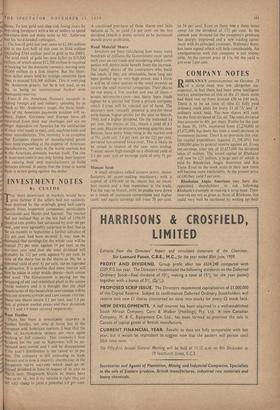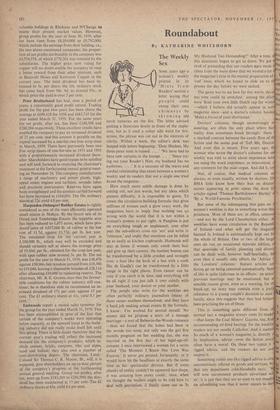COMPANY NOTES
RHOKANA'S announcement on October 23 of a scrip issue was not altogether un- expected; in fact there had been some intelligent market anticipation of this as the £1 stock units had been run up from around £30 to £40 each. There is to be an issue of nine 1 fully paid ordinary stock units for every £1 of 'A' and 'A' ordinary stock held. The new shares will rank for the final dividend of 32s. 6d. The total dividend thus amounts to 40s. per share. Profits for the year to June 30, 1959, recovered from £3,238,00() to £5,673,000, but there has been a small decrease in investment income. There is no provision this year for capital expenditure (against £1,398,101), but £500,000 goes to general reserve against nil. From net earnings, after tax, of £5,625,000 the dividend takes £5 million. The issued capital of Rhokana will now be £25 million, a large part of which is held by Rhodesian Anglo American and Rio Tinto. Even so the stock units in their new form will become more marketable. At the present price of £40 they yield 5 per cent.
Rhodesian Anglo American may have dis- appointed shareholders in not following Rhokana's example in making a scrip issue. Their reserves are not as great as those of Rhokana, but could very well be increased by writing up their
valuable holdings in Rhokana and N'Changa to nearer their present market values, However, group profits for the year to June 30, 1959, after tax have risen from £8,104,000 to £9,792,000, which include the earnings from their holding, i.e., the two above-mentioned companies; the propor- tion of net profits attributable to the company was £4,554,574, of which £770,361 was retained by the subsidiaries. The higher price now ruling for copper will no doubt enable the company to reap a better reward from their other interests, such as Bancroft Mines and Kenveestt Copper in the current year. The total dividend has been in- creased to 5s. per share; the 10s. ordinary stock has come back from 98s. 9d. to around 95s., at which price the yield is over 5 per cent.
Peter Brotherhood has had, over a period of years, a consistently good profit record. Trading profit for the past two years has been above the average at £698,418 for 1958 and £683,745 for the year ended March 31, 1959. For the same years the net profit, after tax, has been £240,508 and £280,204 respectively. These excellent results have enabled the company to pay an increased dividend of 25 per cent, and this amount is payable on the capital increased by a one-for-two free scrip issue in March, 1959. There have previously been two free scrip issues of one-for-one in 1953 and 1955 with a" proportionately increased dividend there- after.Shareholders have good reason to be satisfied and will look forward to receiving the chairman's statement at the forthcoming annual general meet- ing on November 24. The company manufactures a range of machinery and power plants, high- speed steam engines and turbines, torpedo tubes and precision instruments. Reserves have again been strengthened and the amount carried forward has been increased at £164,696. The 10s. ordinary shares at 52s. yield 4.8 per cent.
Harpenden (Selangor) Rubber Estates is rightly considered as one of the most efficiently operated small estates in Malaya. By the recent sale of its Oxted and Tanebridge Estates the tappable area has been reduced to 1,075 acres, which have pro- duced Sales of 4.037,000 lb. of rubber at the low cost of 11.7d. against 13.77d. per lb. last year. The estimated crop for the current year is 1,100,000 lb., which may well be exceeded and should certainly sell at above , the average price of 19.69d. per lb., obtained for the crop last year, with spot rubber now around 3s. per lb. The net profit for the year to March 31, 1959, was £38,476 against £30,966, but taxation jumped from £10,306 to £19,040, leaving a disposable balance of £28,116 after allocating £10,0013 to replanting reserve. The chairman, Mr. B. E. Greene,isays that the favour- able conditions for the rubber industry still con- tinue; he is therefore able to recommend, an in- creased dividend of 17+ per cent. against 15 per cent. The £1 ordinary shares at 41s. yield 8.5 per cent.
Eastwoods report a record sales turnover for the group for the year ended March 31, 1959. This has been accomplished in spite of the fact that certain of the company's works were operating below capacity, as the upward trend in the build- ing industry did not really make itself felt until this spring. There is little doubt therefore that the current year's trading will reflect the increased demand for the company's produCts, which in- clude cement, bricks, conFrete, tiles and pipes, sand and ballast; they also own a number of coal-distributing depots. The chairman, Lieut.- Colonel Sir Thomas C. R. Moore, Bt., will, it is expected, give shareholders an up-to-date picture of the company's progress at the forthcoming annual general meeting. Group net profits, after tax, were up from £183,369 to £286,990; the divi- dend has been maintained at 15 per cent. The Ll ordinary shares at 65s. yield 4.6 per cent.











































 Previous page
Previous page